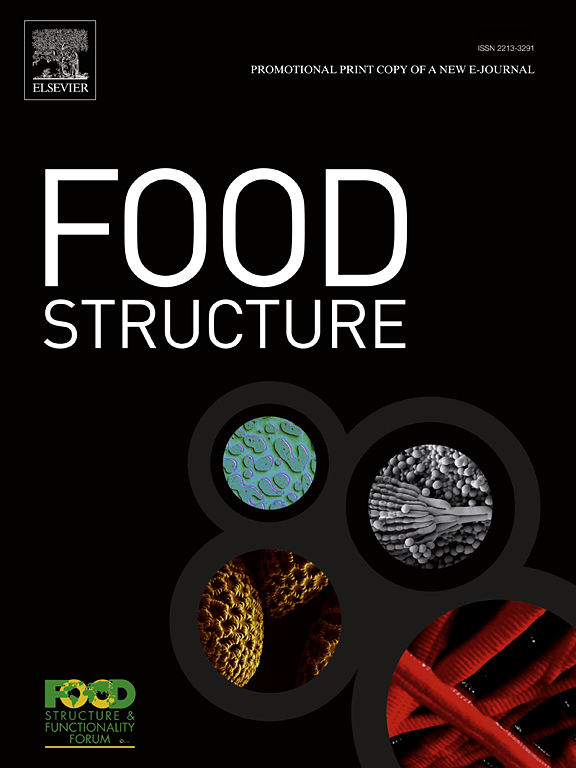淀粉-海藻酸钠互穿网络的构建是提高挤压荞麦面再加热和浸泡质量的有效策略
IF 5.9
3区 农林科学
Q1 FOOD SCIENCE & TECHNOLOGY
引用次数: 0
摘要
本研究通过建立淀粉-海藻酸钠互穿网络增强体系,制备膨化荞麦面条。系统地探讨了再加热方式和浸泡时间对面条结构和质量特性的影响。与浸泡沸水和沸水蒸煮相比,微波沸水再加热的再加热时间最短(2.33 min),但再加热损失(6.94 %)和汤浊度(3.23 NTU)最高。SEM结果表明,用沸水微波加热的面条孔隙率最高(57.32 %),节数最低(423)。沸水浸泡后的面条硬度、拉伸力和断裂伸长率最高,分别达到51.52 N、0.131 N和90.3 %。用沸水微波加热的面条的pGI值最高,为71.98。沸水蒸煮至最佳蒸煮时间后,再继续浸泡30 min,互穿凝胶网络保持较好的网络状态,再热损失仅从5.44 %增加到9.44 %。在体外消化过程中,其pGI值缓慢上升至83.98,远低于小麦面条的92.20。与沸水微波再加热相比,沸水浸泡的再加热时间更长,但再加热损失更小,面条结构更稳定。而沸水蒸平衡了再加热时间和损失。总的来说,每种加热方法都有其优点和缺点,并且都对荞麦面条的质量产生了显着影响。本文章由计算机程序翻译,如有差异,请以英文原文为准。
Construction of starch-sodium alginate interpenetrating network as an effective strategy to improve the quality of extruded whole buckwheat noodles during reheating and soaking periods
In this study, extruded whole buckwheat noodles were prepared by establishing a starch-sodium alginate interpenetrating network reinforcement system. The impacts of reheating methods and soaking time on the structural and quality characteristics of the noodles were also systematically explored. Compared with immersion in boiling water and steaming with boiling water, microwave reheating with boiling water had the shortest reheating time (2.33 min), yet the highest reheating loss (6.94 %) and soup turbidity (3.23 NTU). SEM results indicated that the noodles reheated by microwave with boiling water had the highest porosity (57.32 %) and the lowest number of knots (423). The hardness, tensile force and elongation at break of the noodles after immersion in boiling water were the highest, reaching 51.52 N, 0.131 N and 90.3 % respectively. Additionally, the noodles reheated by microwave with boiling water obtained the highest pGI value of 71.98. After steaming with boiling water to the optimal steaming time and then continuing to soak for 30 min, the interpenetrating gel network maintained a relatively good network state, and the reheating loss only increased from 5.44 % to 9.44 %. During in vitro digestion, its pGI value slowly increased to 83.98, which was much lower than that of wheat noodles (92.20). Compared with boiling water-microwave reheating, boiling water immersion required a longer reheating time but had lower reheating loss and more stable noodle structure. Whereas boiling water steaming balances reheating time and loss. Overall, each reheating method had its pros and cons, and all exerted significant impacts on buckwheat noodle quality.
求助全文
通过发布文献求助,成功后即可免费获取论文全文。
去求助
来源期刊

Food Structure-Netherlands
Chemical Engineering-Bioengineering
CiteScore
7.20
自引率
0.00%
发文量
48
期刊介绍:
Food Structure is the premier international forum devoted to the publication of high-quality original research on food structure. The focus of this journal is on food structure in the context of its relationship with molecular composition, processing and macroscopic properties (e.g., shelf stability, sensory properties, etc.). Manuscripts that only report qualitative findings and micrographs and that lack sound hypothesis-driven, quantitative structure-function research are not accepted. Significance of the research findings for the food science community and/or industry must also be highlighted.
 求助内容:
求助内容: 应助结果提醒方式:
应助结果提醒方式:


